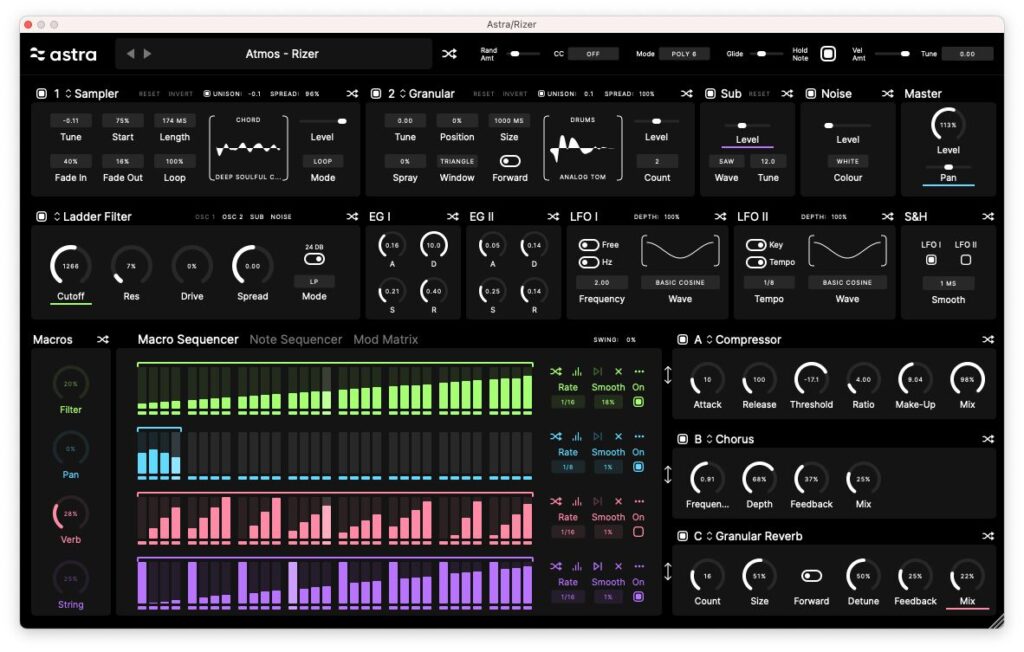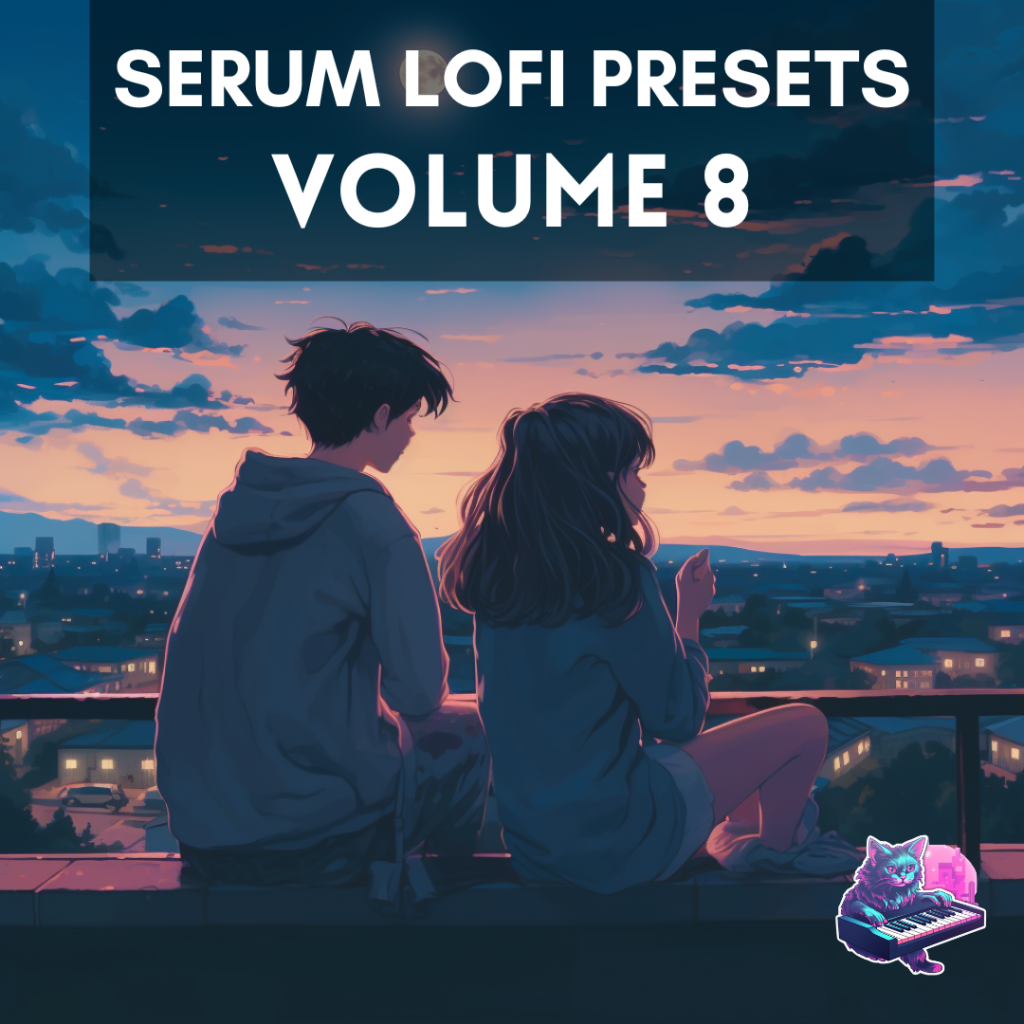
One of the most powerful tools for creating authentic lofi vibes is Serum, a versatile and powerful wavetable synthesizer. With a vast array of Serum presets at your disposal, you can quickly and easily achieve the distinct sound characteristics that define lofi music. In this guide, we’ll explore step-by-step instructions for crafting your own lofi masterpieces using Serum presets.
Crafting the Perfect Lofi Melodies with Serum Presets
Melodies are the foundation of any lofi track, so let’s start by discussing how to create engaging and emotive melodies using Serum presets. To achieve that nostalgic lofi vibe, focus on selecting presets that evoke a sense of warmth and depth.
Picking the Right Presets
When choosing Serum presets for lofi music production, look for sounds that have a rich, warm, and slightly imperfect character. Some popular lofi-friendly Serum presets include:
- Vintage keys: Classic electric pianos and organs
- Analog-style synths: Emulate the warmth and character of vintage hardware
- Textured pads: Add depth and atmosphere to your compositions
Tweaking Presets for Maximum Lofi Character
Once you’ve chosen the perfect Serum presets for your lofi track, it’s time to tweak them to achieve the right sound. Keep these tips and tricks in mind while adjusting your presets:
- Detune oscillators: Add a touch of detuning to introduce subtle pitch fluctuations, mimicking the unstable pitch of old hardware
- Embrace imperfections: Apply subtle LFO modulation to parameters like filter cutoff, pitch, and amplitude to create movement and organic textures
- Use distortion: Experiment with different types of distortion to add warmth and grit to your sounds
Diving Deep into Crafting Custom Drum Sounds
A crucial aspect of crafting authentic lofi vibes is designing the perfect drum grooves. Serum presets can be an invaluable resource for creating unique and engaging percussion elements.
While Serum is known for its melodic prowess, it’s also a powerful tool for drum synthesis. Custom drum sounds add a layer of authenticity to your lofi vibes that pre-packaged drum samples may struggle to replicate. But how can you extract rich, lofi percussion elements from Serum’s presets? Let’s delve deep into the process.
The Rhythmic Essence: Kicks, Snares, and Hats
The holy trinity of drum sounds in lofi music comprises the kick, snare, and hi-hat. Each plays a unique role in the overall groove, and Serum offers a plethora of possibilities to shape these sounds to your liking.
Kicks: The Heartbeat of Your Track
The kick drum is the heartbeat of your track. It provides the fundamental pulse, driving the rhythm forward. Crafting an engaging lofi kick involves designing a sound that is punchy yet muffled, retaining enough bass to provide a solid rhythmic foundation.
To create a lofi kick in Serum:
- Choose a basic waveform: Start by choosing a simple waveform such as a sine wave. The clean harmonic content of a sine wave makes it ideal for crafting punchy, bass-heavy kicks.
- Manipulate the envelope: Adjust the amplitude envelope to give your kick drum its shape. Fast attack, short decay, and zero sustain and release should be your starting point.
- Pitch envelope modulation: Apply a quick, downwards pitch envelope modulation to give the kick its thud. Start at a high pitch and quickly slide down to the bass frequencies.
- Distortion and EQ: Apply mild distortion to add warmth and character. Finish off with some EQ to accentuate the bass frequencies and roll off the high end for that signature lofi warmth.
Snares: The Backbeat
Lofi snares typically have a dirty, gritty quality, often imitating the sound of a vintage drum machine or a lo-fi recording. In Serum, you can create these unique snare timbres by combining synthesis with noise generation.
- Combine waveforms and noise: Start with a basic waveform such as a square wave, then layer it with a noise oscillator to add texture.
- Envelope shaping: Much like the kick, shape the amplitude envelope with a fast attack and short decay. Zero sustain and a slightly longer release will give your snare a natural-sounding tail.
- Pitch modulation and distortion: Apply a pitch envelope to the oscillator and noise source, starting high and falling rapidly. This gives your snare its sharp, percussive quality. Add some light distortion to give it grit.
- EQ and Reverb: EQ the snare to boost the mid frequencies and cut the lows and high ends. A touch of reverb can help add space and depth.
Hi-Hats: The Rhythmic Spice
Hi-hats in lofi music have a characteristic sizzle and flutter, often sounding as if they’re sampled from a dusty vinyl record. With Serum’s flexible noise generator and envelope shaping capabilities, creating these captivating hi-hat sounds is a breeze.
- Noise generation: Start by choosing a suitable noise source in Serum. White noise works well for hi-hats due to its broad frequency content.
- Envelope shaping: Adjust the amplitude envelope with a fast attack, short decay, and zero sustain and release. This gives the hi-hat its sharp, percussive character.
- Filtering: Apply a high-pass filter to remove the lower frequencies, shaping the white noise into a hi-hat sound.
- Velocity and groove: The magic of lofi hi-hats often lies in their subtle variations in velocity and timing,
Lofi Drum Processing Techniques
Once you’ve created your drum sounds using Serum presets, it’s time to process them for that quintessential lofi character. Some useful techniques include:
- Bitcrushing: Reducing the bit depth or sample rate of your drums adds digital artifacts reminiscent of vintage samplers
- Vinyl emulation: Plugins like iZotope Vinyl or Waves Abbey Road Vinyl add warmth, crackle, and other vinyl imperfections
- Tape saturation: Apply tape saturation effects to simulate the sound of analog tape machines
Crafting Atmospheric Lofi Textures
Atmospheric textures play a crucial role in constructing a lofi soundscape. They act as the sonic backdrop, setting the scene, and creating the ambiance. These textures often resemble the comforting sounds of old vinyl records or radio static, establishing a warm, vintage mood. Let’s dive into how we can create these immersive textures with Serum presets.
The Concept of Lofi Textures
The appeal of lofi music lies in its raw, nostalgic charm – the aural equivalent of a vintage, sepia-tinted photograph. The atmospheric textures in lofi music often resemble background noise, featuring sounds such as vinyl crackles, tape hiss, radio static, or ambient nature sounds. These elements create a sense of warmth and familiarity, transforming a simple beat into an immersive soundscape.
Designing Lofi Textures with Serum Presets
Creating atmospheric lofi textures with Serum involves a combination of sound design techniques. We’ll be utilizing Serum’s noise oscillator, filters, and modulation capabilities to craft unique, engaging textures.
Here’s an example of how to create a custom vinyl crackle texture with Serum:
- Starting with Noise: First, disable Serum’s oscillators A and B, and enable the noise oscillator. Within the noise oscillator, select the
Analog_LP_Noisepreset. This provides a basic white noise sound, acting as the raw material for our texture. - Adjusting the Envelope: Set the amplitude envelope with a slow attack and release, with a sustain level at 100%. This allows the noise to fade in and out smoothly, mimicking the sound of a vinyl record playing.
- Filtering for Texture: Apply a low-pass filter to the noise oscillator. This cuts off the higher frequencies, leaving a warmer, darker sound that resembles the hiss of an old vinyl record. Adjust the filter cutoff to taste, finding the sweet spot where the sound is warm but still has enough presence.
- Modulating for Movement: Apply an LFO to the filter cutoff. This creates a subtle, slow-moving modulation that gives the texture a sense of movement and life. Set the LFO rate to a low value for a slow, gradual modulation effect.
- Adding Reverb and Distortion: Finally, use Serum’s built-in FX to add the finishing touches. Apply a bit of tube distortion for extra warmth, and add a generous amount of reverb for depth and space.
The result is a custom, atmospheric lofi texture that you can use as a backdrop in your lofi tracks.
Sound Design Tips for Lofi Textures
To create the perfect lofi textures using Serum presets, consider the following sound design tips:
- Layer noise sources: Combine different types of noise (white, pink, brown, vinyl crackle, etc.) to create a dense and textured atmosphere
- Use filters and modulation: Apply low-pass filters with subtle LFO modulation to create movement and depth in your ambient sounds
- Experiment with reverb and delay: Generous amounts of reverb and delay can transform simple sounds into lush, evolving textures
Mastering in the Realm of Lofi: Retaining Authenticity
Once your track is mixed and all the elements sit nicely together, it’s time for the final stage of the music production process: mastering. Mastering in the lofi genre is a delicate operation. It’s an art of preserving and accentuating the gritty, raw aesthetic of lofi, rather than refining and polishing the mix to perfection. Below, we delve into key considerations when mastering lofi music.
Dynamic Range: Less is More
In an era where the loudness war often dominates mastering discussions, lofi is a pleasant exception. One of the distinctive characteristics of lofi music is its wide dynamic range. This dynamic freedom is a big part of the lofi charm, capturing the raw and natural feel of the music.
Over-compression or limiting is antithetical to the ethos of lofi music production. Preserve the dynamic range of your mix. Allow those quiet moments to remain quiet and let louder passages sing, breathing life and energy into your music. Utilize a limiter only to prevent potential digital clipping and keep the gain reduction minimal.
Warmth and Saturation: The Lofi Aesthetic
Warmth and saturation are essential components of the lofi sound. They represent the sonic footprint of analog gear, contributing to the nostalgic and inviting vibe that defines lofi music.
Mastering with a lofi mindset involves adding this warmth and saturation, often via plugins that emulate tape or tube saturation. These plugins add harmonics, subtle compression, and even noise, contributing to the richness and depth of the mix. Experiment with different types and amounts of saturation, listening carefully to find the sweet spot where the saturation enhances the warmth and character of the mix without overwhelming it.
EQ: Gentle Adjustments for Tonal Balance
Mastering EQ in lofi involves making gentle, broad adjustments to balance the tonal characteristics of the mix. With lofi music, it’s crucial to respect the mid-range warmth and avoid hyping the high frequencies. Often, a subtle low-shelf boost can add a pleasant warmth, and a gentle high-shelf cut can help tame any harshness or excess brightness.
Embracing the Imperfections
Perhaps the most significant aspect of mastering lofi music is embracing the genre’s inherent imperfections. These imperfections – the noise, the subtle pitch fluctuations, the bitcrushing – these are not only acceptable in lofi music, they are desired. They contribute to the raw, nostalgic vibe that makes lofi music so unique and appealing.
As such, it’s crucial to approach mastering with an open mind. Listen to the idiosyncrasies in your mix and consider how they contribute to the overall vibe. Instead of trying to eliminate these “flaws,” think about how to enhance them. Maybe that noise could be a bit louder, or that vinyl crackle could be more prominent. Use your mastering tools to emphasize these elements and elevate the lofi aesthetic of your track.
Mastering for lofi music isn’t about polishing and perfecting your mix; it’s about enhancing and emphasizing the unique characteristics that define the lofi genre. By approaching the mastering process with a lofi mindset, you can preserve the raw, nostalgic vibe of your music, creating tracks that captivate listeners with their warmth, depth, and authenticity.
Lofi Serum Preset Cheatsheet
| Category | Serum Preset Tips & Techniques |
|---|---|
| Melodies | Vintage keys, analog-style synths, textured pads, detune oscillators |
| Drums | Custom drum sounds, bitcrushing, vinyl emulation, tape saturation |
| Textures | Layer noise sources, filter modulation, reverb and delay |
| Mixing | EQ, compression, sidechain processing |
| Mastering | Preserve dynamic range, warmth and saturation, embrace imperfections |
By following this extensive guide, you’ll be well on your way to creating authentic lofi vibes using Serum presets. With a strong foundation in sound design, drum grooves, textures, and mixing and mastering techniques, you’ll be able to craft lofi tracks that transport listeners to a warm and nostalgic world. So, fire up Serum, explore your favorite presets, and start your lofi music production journey today.





